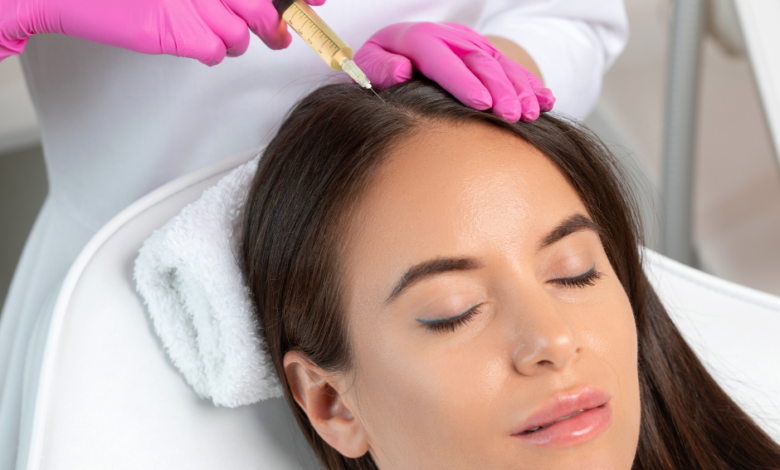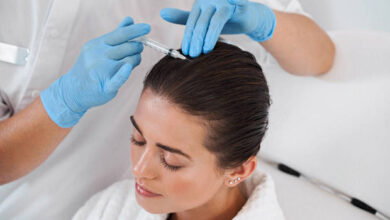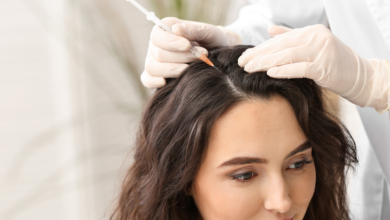
Are you a woman struggling with hair loss? At Stylish.ae, we understand that hair loss can significantly impact a woman’s self-esteem and confidence. That’s why we have developed a specialized approach to hair transplants, specifically tailored to address the unique needs of women. Our team of experienced professionals combines advanced technology with a deep understanding of female hair restoration to provide natural-looking and long-lasting results.
Whether you are dealing with thinning hair, receding hairline, or bald patches, Stylish.ae is here to help you regain your hair and confidence. Trust our expertise to rejuvenate your appearance and restore your self-assurance.
Understanding Hair Loss in Women
Causes of Hair Loss in Women
Hair loss in women can be caused by a variety of factors, both genetic and environmental. One of the most common causes is Androgenetic Alopecia, also known as female pattern hair loss. It is believed to be inherited and occurs when the hair follicles shrink over time, resulting in thinning hair and a receding hairline.
Other potential causes of hair loss in women include hormonal changes, such as those experienced during pregnancy or menopause, as well as certain medical conditions like polycystic ovary syndrome (PCOS) and thyroid disorders. Additionally, lifestyle factors such as stress, poor nutrition, and excessive hairstyling can contribute to hair loss in women.
Common Patterns of Hair Loss in Women
Hair loss in women typically manifests in different patterns compared to men. While men often experience receding hairlines and bald spots, women tend to experience overall thinning of the hair. This can be seen as a widening part line or a decrease in hair density throughout the scalp.
Emotional Impact of Hair Loss on Women
Hair loss can have a significant emotional impact on women. Many women consider their hair to be an important part of their identity and femininity, so losing their hair can lead to feelings of self-consciousness, embarrassment, and even depression. It is important to address the emotional impact of hair loss when considering hair transplant options for women.

Hair Transplant Techniques for Women
Follicular Unit Extraction (FUE)
Follicular Unit Extraction (FUE) is a popular hair transplant technique for both men and women. During this procedure, individual hair follicles are harvested from the donor area, typically at the back of the head, and then transplanted to the recipient area where hair loss has occurred. This technique ensures that the transplanted hair looks natural and blends seamlessly with the existing hair.
Direct Hair Implantation Technique (DHI)
The Direct Hair Implantation Technique (DHI) is another advanced hair transplant technique suitable for women. DHI involves the use of a specialized pen-like device called a Choi Implanter, which enables precise implantation of the harvested hair follicles into the recipient area. This technique allows for a higher density of hair transplants and reduces scarring.
Robotic Hair Transplantation
Robotic Hair Transplantation is a cutting-edge hair transplant technique that utilizes robotic technology for precise and accurate extraction and placement of hair follicles. This technique ensures minimal scarring, reduces the risk of human error, and allows for faster and more efficient hair transplant procedures.

Evaluating Candidacy for Hair Transplants
Assessing the Severity and Type of Hair Loss
Before undergoing a hair transplant, it is crucial to assess the severity and type of hair loss to determine candidacy. A thorough evaluation by a qualified hair transplant specialist will help determine the best course of action and provide realistic expectations for the outcome.
Evaluating the Donor Area
The donor area refers to the region from which hair follicles will be extracted for transplantation. It is essential to evaluate the quality and density of the hair in the donor area to ensure sufficient follicles can be harvested for transplantation.
Considering Hair Texture and Density
Hair texture and density play a significant role in determining the success of a hair transplant. Evaluating the texture and density of the patient’s existing hair will help determine the appropriate transplantation method and ensure a natural-looking result.

The Procedure: Step by Step
Pre-Operative Consultation
A pre-operative consultation is an essential step in the hair transplant process. During this consultation, the surgeon will assess the patient’s hair loss, evaluate the donor area, discuss the patient’s goals and expectations, and answer any questions or concerns.
Anesthesia and Local Numbing
Before the transplant procedure begins, anesthesia and local numbing will be administered to ensure the patient’s comfort throughout the process. Anesthesia options may vary depending on the techniques used and the patient’s preferences.
Donor Area Extraction
Using the chosen technique (FUE, DHI, or robotic), the surgeon will extract individual hair follicles from the donor area. This process is performed with precision to ensure the follicles remain intact and ready for transplantation.
Extraction Site Preparation
Once the hair follicles are extracted, the surgeon will prepare the recipient area for transplantation. This involves creating tiny incisions or puncture holes, where the extracted follicles will be implanted.
Graft Placement
In this step, the surgeon will carefully implant the extracted follicles into the recipient area. The placement of the grafts is crucial to achieving a natural-looking result, and the surgeon will consider factors such as hairline design and density during this process.
Post-Operative Care
After the hair transplant procedure is complete, the patient will receive instructions for post-operative care. This may include guidelines for gentle hair washing, use of prescribed medications, and information on potential side effects or discomfort during the healing process.
Follow-Up Visits
Follow-up visits are an essential part of the hair transplant journey. These visits allow the surgeon to monitor the progress of the transplanted hair and ensure optimal healing. The patient will also have the opportunity to address any concerns or questions with the surgeon.
Special Considerations for Female Hair Transplants
Preservation of Hairline and Hair Density
Preserving the natural hairline and achieving a balanced hair density is crucial in female hair transplants. Careful planning and precise placement of the grafts are necessary to ensure a natural-looking result that complements the patient’s facial features.
Transplanting Hair in Thinning Areas
Transplanting hair in areas of thinning is a common concern for women. Skilled surgeons can address these concerns by carefully selecting the appropriate hair follicles for transplantation and strategically placing them to achieve improved hair density in thinning areas.
Addressing Hormonal Hair Loss
Hormonal hair loss, such as that caused by pregnancy or menopause, requires special attention during the hair transplant process. Surgeons who specialize in female hair transplants understand the hormonal factors at play and can tailor the procedure to address these specific concerns.
Duration of Results and Maintenance
Longevity of Transplanted Hair
Transplanted hair follicles have the potential to last a lifetime, as they are typically resistant to the effects of DHT (dihydrotestosterone), the hormone responsible for male and female pattern hair loss. However, it is essential to note that hair transplant outcomes can vary depending on individual factors, so regular maintenance may be necessary.
Hair Maintenance Tips for Women
To maintain the results of a hair transplant, women should follow a healthy hair care routine. This includes regular washing with gentle shampoos, avoiding excessive heat styling or chemical treatments, and protecting the hair from sun damage. Additionally, a balanced diet and good overall health are essential for maintaining healthy hair.

Risks and Possible Complications
Infection or Bleeding
As with any surgical procedure, there is a risk of infection or bleeding following a hair transplant. However, by choosing a reputable and experienced hair transplant clinic and following proper post-operative care instructions, the risk of these complications can be minimized.
Scarring and Skin Changes
While modern hair transplant techniques aim to minimize scarring, it is possible to experience some scarring or changes in the skin texture following a hair transplant. These are usually minimal and fade over time, but it is important to discuss any concerns with the surgeon during the consultation process.
Shock Loss or Temporary Hair Shedding
Shock loss, also known as temporary hair shedding, can occur after a hair transplant. This is a normal part of the hair growth cycle and should not cause alarm. The transplanted hair follicles will naturally go through a resting phase before regrowth, which typically begins within a few months after the procedure.
Finding the Right Hair Transplant Clinic
Researching Accredited Hair Transplant Clinics
When seeking a hair transplant clinic, it is important to research and choose an accredited clinic that meets the highest standards of safety, quality, and professionalism. Accreditation ensures that the clinic adheres to strict guidelines and employs highly skilled professionals.
Reading Patient Reviews and Testimonials
Reading patient reviews and testimonials is an excellent way to gauge the reputation and quality of a hair transplant clinic. Real-life experiences and feedback from previous patients can provide valuable insights into the clinic’s expertise, patient satisfaction, and overall success rates.
Consulting with Experienced Surgeons
Consulting with experienced hair transplant surgeons is crucial in making an informed decision. During the consultation, the surgeon will assess your specific needs, evaluate your candidacy, and address any concerns or questions you may have. This interaction will help you determine if the clinic and surgeon are the right fit for you.
Cost of Hair Transplants for Women
Factors Influencing the Cost of Women’s Hair Transplants
The cost of women’s hair transplants can vary depending on several factors. These factors include the extent and type of hair loss, the chosen technique, the number of grafts required, the experience and reputation of the surgeon, and the location of the clinic. It is important to consider these factors when estimating the cost of a hair transplant.
Financing Options and Insurance Coverage
Hair transplant procedures for women may not always be covered by insurance, as they are often considered elective cosmetic procedures. However, some clinics may offer financing options to help make the procedure more affordable. It is advisable to discuss financing options with the clinic during the consultation process.
Boosting Confidence and Self-Esteem with Hair Transplants
Psychological Effects of Hair Restoration
Hair restoration through transplants can have a profound positive impact on a woman’s psychological well-being. Restoring lost hair can significantly boost confidence and self-esteem, allowing women to regain a sense of control and feel more comfortable in their own skin.
Personal Stories of Women Regaining Confidence
Countless women have experienced the life-changing effects of hair transplants, restoring their confidence and self-esteem. These personal stories serve as valuable inspiration and reassurance for women considering hair transplants, showing that it is possible to regain a full head of hair and embrace one’s beauty with pride.
In summary, understanding hair loss in women and the unique factors that contribute to it is essential when considering hair transplant options. By exploring the causes, patterns, and emotional impact of hair loss, women can make informed decisions about the most appropriate techniques and clinics for their individual needs. Evaluating candidacy, understanding the procedure, and being aware of potential risks and costs are all crucial steps in the hair transplant process. Ultimately, hair transplants can be a transformative experience for women, helping them regain confidence and feel empowered in their appearance.




